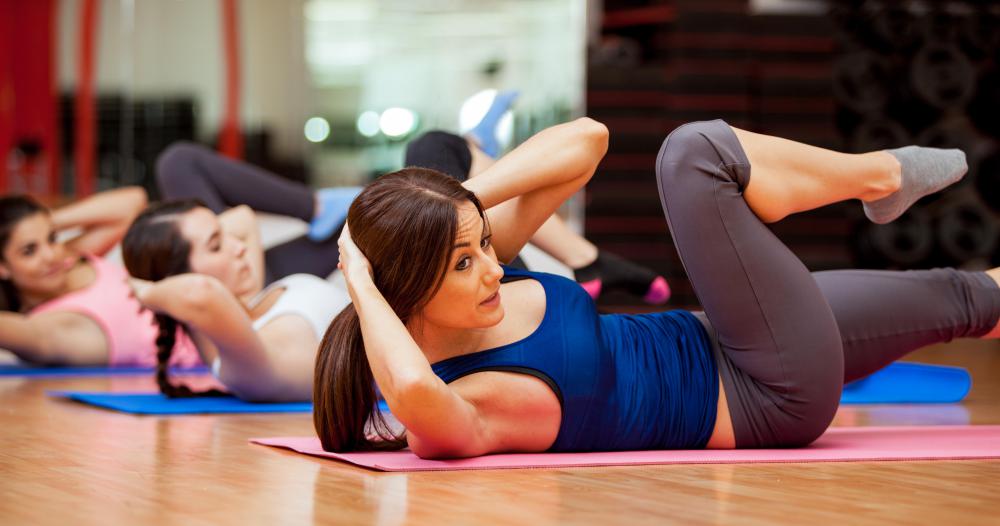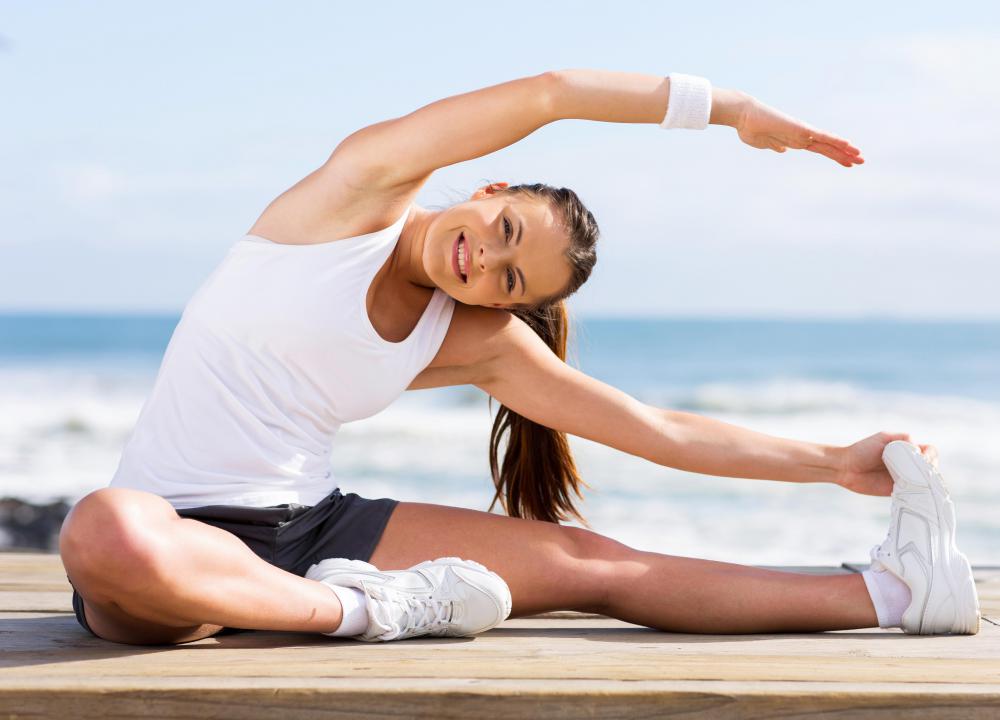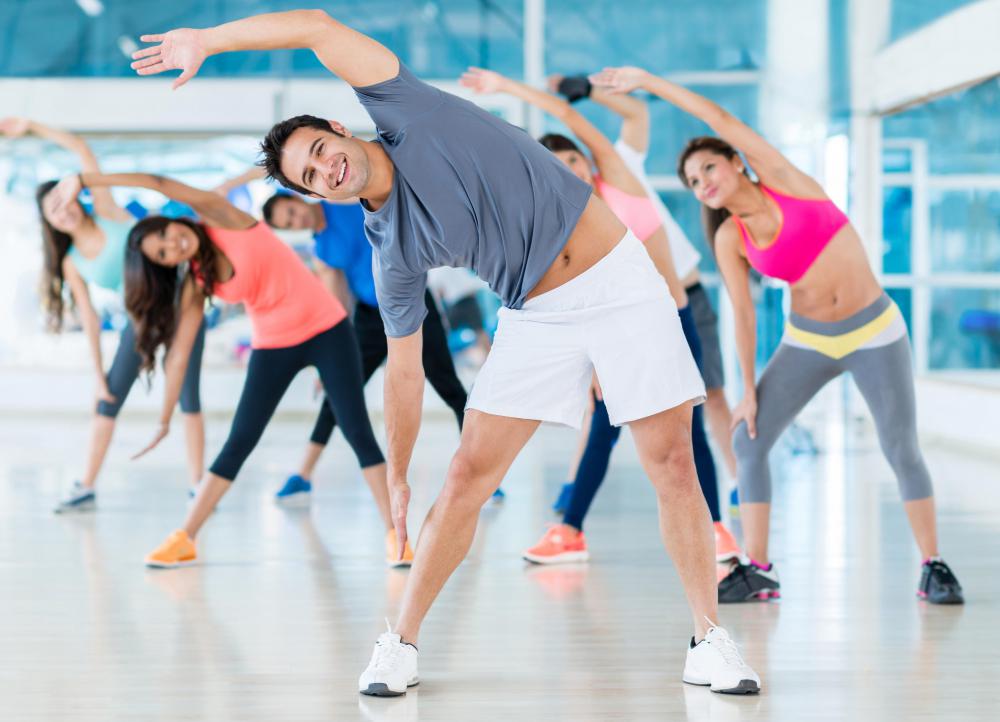At TheHealthBoard, we're committed to delivering accurate, trustworthy information. Our expert-authored content is rigorously fact-checked and sourced from credible authorities. Discover how we uphold the highest standards in providing you with reliable knowledge.
What Are Obliques?
Obliques is a term referring to muscles on the side of the upper body that help to assist in turning the body from side to side. They are actually two sets of obliques, called internal and external and each set contracts in a different way during twisting or side-to-side movements. This is the area of the body is also where the famous “love handles” develop, which people work so hard to eradicate.
In the front of the abdomen, there is a major muscle called the rectus abdominis, which stretches from pubis to the ribs. On either side of the rectus abdominis, right at the hips, the internal obliques are located. The external obliques are higher, on either side of the rectus abdominis, and start at the rib cage.

Anytime a person twists the body, both sets of obliques work, but action of each muscle depends on the side to which a person twists. The internal oblique involved when a person twists is located on the same of the side of the twist. For instance, twist to the left and the left internal oblique gets a stretch. In contrast, a twist to the left works the right external oblique muscle, or the one opposite to the direction of the twist. It’s easy to feel this, and the slight pull on the rib cage and chest that occurs when a person engages in a twist.

There is great desire to tone obliques since they can help create a shapely waist, and also cause freer movement. Many of the basic sit-ups and crunches won’t adequately tone oblique muscles, because they involve up and down movement instead of twisting movement. When a crunch incorporates a twist to the side, as the other stomach muscles are contracted, oblique muscles are worked too, and the exercise may be more efficient.

A good sit-up plus twisting exercise is touching the opposite elbows to opposite knees when the body is in the crunch position. This helps use the obliques at the same time it works the rectus abdominis. Such an exercise may be called bicycle crunches.
Other exercises that can work these side abdominal muscles include side bends and waist twists, with or without small weights, which may help lengthen and tone oblique muscles. Many types of exercises that are called “core muscle” exercises, at least partially address obliques, and can be useful in toning this area, while maintaining good range of motion.
Why Obliques Get Sore During and After Running

People often assume that they will only get sore muscles when they work out a specific muscle group. It makes sense, therefore, that they would expect leg soreness rather than discomfort in the obliques. But the obliques are almost always active when standing upright and moving.
If soreness is persistent during or after a run, it may indicate that they were highly engaged during the exercise. If the person working out is unaccustomed to intense exercise, it's not unusual to experience soreness in surprising places.

There are a few reasons that the obliques, in particular, may be sore during or after a run that has nothing to do with fatigue. Injury is the most significant and should be addressed by a professional. Pain from damage to the obliques will be severe and drastically reduce the range of motion. A person may feel this pain in the side, abdomen, or back.

However, most often, cramps or stitches cause side pain during a run. There's no confirmed reason for getting a stitch, but it's most likely due to a restriction of oxygen or irritated abdominal walls. When this happens, a runner can reduce symptoms by slowing down and taking deep breaths.
How To Stretch Obliques
Strengthening muscles is not the only essential exercise for obliques. People also need to emphasize stretching to gain more control and mobility from the obliques. Below are a few stretches that are perfect for lengthening the obliques.
Standing Bend
With feet shoulder-width apart, a person can stretch their arms above their head, pointing their palms toward the ceiling. In that position, they can lean slightly backward and side to side.
Sitting Bend
This is the same stretch as the standing bend but done in a seated position. This variation can help maintain control and prevent someone from overstretching or losing balance.
Windshield Wipers

This stretch is done while lying flat on the back. The person completing the stretch should tuck their knees toward the chest, with legs level. Then, slowly, gently lean their lower body to one side and then the other. Their legs will move across the center of the body like windshield wipers.
How To Care for Sore Obliques
Everyone will inevitably deal with sore obliques at some point. They're a crucial part of the body that plays a significant role in day-to-day activities. Whether it's due to an injury or workout recovery, caring for the obliques when they're sore is important for overall health.
Get Plenty of Rest
Overusing your muscles is dangerous and increases the risk of further injury. Avoiding activities that require excessive bending, twisting, or sudden movements is wise. Instead, getting extra sleep and rest can help muscles recover.
Consume More Protein
Upping protein intake is also important in assisting muscles to recover. Proteins make up the muscles. Muscles will have shorter recovery times by including more protein-rich foods throughout the day.
Take an Ice Bath
Ice baths are also an unpleasant but effective way to reduce muscle pain. The cold causes blood vessels to restrict, which can help reduce swelling. This, in turn, can minimize general soreness after a hard workout or injury.
Massages
Massage is also a good way to relax sore, stiff muscles. If the obliques are particularly tight or overworked, there's a good chance they're not getting good circulation. Massage can help increase blood flow and relax the body.
Why Are Obliques Important?
Toned obliques look great, but they're also essential for completing everyday tasks. It might be surprising to find out all of the important skills in which obliques participate. Below are some of the things people do that involve the obliques.
Twisting
Twisting the upper body heavily relies on the obliques. That's why many exercises targeting the obliques involve twisting side to side.
Bending
Leaning over and, more importantly, standing back up require the obliques to be engaged. Engaging the obliques when bending over can help protect back muscles.
Reaching
People typically think of the arm and shoulder muscles as the powerhouses of the arms. The obliques also play a significant role in reaching, however. Tight or weak obliques can make reaching and stabilizing objects above the head difficult.
Frequently Asked Questions
What are obliques?
The muscles on the sides of the abdomen are called obliques. They are crucial to core stability and strength because they cause lateral bending and rotation of the spine. The internal obliques and the exterior obliques are the two groups of obliques. The external obliques are situated below the internal obliques, which run counterclockwise to them. They support spinal stabilization and rotation in addition to compressing the abdominal contents. The external obliques go diagonally up and across the body from the sides of the abdomen. They aid in trunk rotation as well as lateral bending.
What is the best way to target the obliques?
The best dynamic workouts to target the obliques are those that require rotation and lateral bending. Side planks, Russian twists, mountain climbers, and side bends are some workouts that focus on the obliques. It's crucial to have a strong core when performing these exercises, as well as a neutral spine. The objective is to activate the obliques without straining the lower back. It's crucial to maintain proper form while moving gently and under control.
How do the obliques help with posture?
The obliques aid in good posture by supporting and stabilizing the spine. They assist in maintaining the spine's neutral alignment, which helps lessen low back discomfort and enhance posture. Poor posture might result from weak obliques since they can't support and stabilize the spine as well. By boosting stability and preventing the spine from slouching or rounding, strengthening the obliques can assist in improving posture.
Are obliques important for athletic performance?
Obliques do matter for athletic performance. When performing motions like sprinting, jumping, and throwing, they assist in supplying stability and support. Additionally, they support rotating motions like swinging a golf club or a bat. Strong obliques can lower the risk of injury while increasing power and speed.
How often should I train my obliques?
Oblique exercises should be performed two to three times a week. It's crucial to concentrate on developing both strength and stability when working out your obliques. A decent routine would incorporate both obliques-targeting exercises and core stabilizing exercises. Additionally, it's crucial to check your form and make sure your lower back isn't being overworked.
AS FEATURED ON:
AS FEATURED ON:

















Discussion Comments
@BrickBack -I also heard that Pilates is great for strengthening the obliques because it works on your core muscles which are mainly in your midsection. I also think that you have to change your diet too if you want to get rid of your love handles because it does not matter what exercise you do if you still eat a lot of junk food.
Your body will still store the excess fat and you will continue to have the love handles. Oblique exercises are important, but proper nutrition is equally important in order to shed those love handles.
I know all about this because I learned the hard way and it took me a long time to realize that I had to change my eating habits too, not just add more exercise to my lifestyle.
@Sunshine31 - I do that too sometimes, but I really like doing oblique crunches because I think that I get the best results from them. I do sit ups in which I have my knees bent and twist upward to the opposite side.
It does burn after a while but it makes a big difference. I also think that an oblique workout should include a strong cardio component. For example, I jump rope in between my oblique crunches and not only does jumping rope help burn the fat from my obliques, but it tones my entire body all over.
I think that if you want to strengthen your obliques you will have to jog or do some other type of high intensity workout that will also sculpt those muscles. I think that jumping rope is as hard as jogging but it does not put as much of a strain on your knees as jogging does.
I used to have problems with love handles until I started lifting weights, but I started doing these oblique exercises with dumbbells and it has really made a difference.
I use three pound weights and stand perfectly straight and with the dumbbells in my hands,and I bend at the waist and alternate sides. I try to hold my stomach muscles in too. In addition, I will also do a boxing motion directly in front of me and will make a fist with the dumbbells and act like I am punching a punching bag.
The exercises for the obliques will strengthen the oblique muscles and allow you to wear those low rider jeans that really hug your hips and are really sexy.
Post your comments